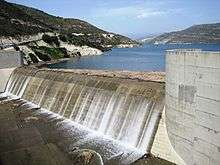Limassol District
Coordinates: 34°47′N 32°55′E / 34.783°N 32.917°E
| Limassol District | |
|---|---|
| District | |
 Location of the district in Cyprus | |
| Country | Cyprus |
| Capital | Limassol |
| Area | |
| • Total | 1,396 km2 (539 sq mi) |
| Population (2011) | |
| • Total | 235,330 |
| • Density | 170/km2 (440/sq mi) |
| Time zone | EET (UTC+2) |
| • Summer (DST) | EEST (UTC+3) |
| Postal code | 3000–4999 |
Limassol District (/ˈlɪməsɒl/) or Lemesos (Greek: Λεμεσός [lemeˈsos]; Turkish: Limasol or Leymosun; Armenian: Լիմասոլ) is one of the six districts of Cyprus. As of 2011, it had a population of 235,330, 77% of which was urban.[1] Its main city is Limassol. Part of the British Overseas Territory of Akrotiri and Dhekelia forms an enclave on the Akrotiri Peninsula, under the sovereignty of the United Kingdom.
History
The buried ancient city of Amathus is 11 kilometres (6.8 mi) from Limassol. Archaeological excavations have unearthed ruins of the Byzantine period and a tomb of the 7th century BC.[2] The ancient Kolossi Castle, which is located 9 kilometres (5.6 mi) to the west of Limassol, reflects the fall of Acre and history of the Templars and their confiscated property allotted to the Limassol District for cultivation of wine and sugarcane.[3]
Geography
Limassol District forms much of the southwestern-central part of Cyprus. The Kouris River rises in the southern slopes of Troodos mountains, which lie in the northern part of the district towards the centre of Cyprus, and flows to the sea near the ancient city of Kourion. This river has been dammed by the Kouris Dam, which has caused the near drying up of the river in its lower reaches.[4] Limassol, to the northeast of the Akrotiri peninsula lies on Akrotiri Bay, while Pissouri, to the northwest of the peninsula, lies on Episkopi Bay.[5] Episkopi Bay is a nesting ground for green and loggerhead turtles, both of which are on the IUCN list of endangered species.[6] Amathous Beach and the Dassoudi Beach are also situated in the district.
Settlements
- Agios Amvrosios
- Agios Athanasios
- Agios Dimitrios
- Agios Georgios
- Agios Ioannis
- Agios Konstantinos
- Agios Mamas
- Agios Pavlos
- Agios Theodoros
- Agios Therapon
- Agios Thomas
- Agios Tychonas
- Agridia
- Agros
- Akapnou
- Akrotiri
- Akrounta
- Alassa
- Alektora
- Amiandos
- Anogyra
- Apesia
- Apsiou
- Arakapas
- Armenochori
- Arsos
- Asgata
- Asomatos
- Avdimou
- Chandria
- Dierona
- Dora
- Doros
- Dymes
- Episkopi
- Eptagoneia
- Erimi
- Fasoula
- Foini
- Foinikaria
- Gerasa
- Germasogeia
- Gerovasa
- Kalo Chorio
- Kaminaria
- Kantou
- Kapilio
- Kato Mylos
- Kato Platres
- Kato Polemidia
- Kellaki
- Kissousa
- Kivides
- Klonari
- Koilani
- Kolossi
- Korfi
- Kouka
- Kyperounta
- Laneia
- Lemithou
- Limassol (capital)
- Limnatis
- Lofou
- Louvaras
- Malia
- Mandria
- Mathikoloni
- Mesa Geitonia
- Monagri
- Monagroulli
- Moni
- Moniatis
- Mouttagiaka
- Omodos
- Pachna
- Palaiomylos
- Palodeia
- Pano Amiantos
- Pano Polemidia
- Paramali
- Paramytha
- Parekklisia
- Pelendri
- Pentakomo
- Pera Pedi
- Pissouri
- Platanisteia
- Platres
- Potamiou
- Potamitissa
- Prastio (Avdimou)
- Prastio (Kellaki)
- Prodromos
- Pyrgos
- Sanida
- Silikou
- Sotira
- Souni–Zanatzia
- Spitali
- Sterakovou
- Sykopetra
- Trachoni
- Treis Elies
- Trimiklini
- Tserkezoi
- Vasa Kellakiou
- Vasa Koilaniou
- Vikla
- Vouni
- Ypsonas
- Zoopigi
Landmarks
Limassol, as the regional capital and a major centre for European tourism, contains many of the administrative and cultural buildings, and a large number of hotels along the seafront. Limassol District Court is located on Lord Byron Avenue near the Limassol city centre. It consists of a court complex with multiple buildings.[7] The city is known for its wineries, and revelry and nightlife.[8] The Limassol District Archaeological Museum, located in Limassol, has historical artefacts from the towns of Kourion and Amathus.[9] The collections cover several periods, including Preneolithic (Akroteri culture), Early Neolithic (Shillourokambos culture), Neolithic I, Neolithic II (Sotira culture), Chalcolithic, Erimi Culture, Early Bronze Age, Μiddle Bronze Age, Late Bronze Age, Cypro-Geometric period, Cypro-Archaic period, Cypro-Classical period, Hellenistic period, Roman period, and Late Roman/Early Christian/Early Byzantine period.[10] The Painted Churches in the Troödos Region is a UNESCO World Heritage Site, and one of the churches, Timios Stavros (Holy Cross) is situated in Pelendria, Limassol District.[11]
References
- ↑ "Population – Place of Residence, 2011". Statistical Service of Cyprus (CYSTAT). 17 April 2014.
- ↑ Weiß et al. 2001, p. 28.
- ↑ Weiß et al. 2001, pp. 26, 28.
- ↑ Jasink & Bombardieri 2010, p. 1.
- ↑ Google (19 April 2015). "Limassol District" (Map). Google Maps. Google. Retrieved 19 April 2015.
- ↑ "Sea turtle mortality in the British Sovereign Base Areas (SBAs) of Episkopi and Akrotiri (Cyprus)". 31st Standing Committee Meeting of the Contracting Parties to the Convention on the Conservation of European Wildlife and Natural Habitat. Retrieved 19 April 2015.
- ↑ "Limassol District Court". Supreme Court of Cyprus. Retrieved 18 April 2015.
- ↑ Weiß et al. 2001, p. 25.
- ↑ Weiß et al. 2001, p. 26.
- ↑ "The Limassol District Archaeological Museum". Limassol Municipal Government. Retrieved 18 April 2015.
- ↑ "Painted Churches in the Troodos Region". UNESCO. Retrieved 10 May 2015.
Bibliography
- Jasink, Anna Margherita; Bombardieri, Luca (2010). Researches in Cypriote History and Archaeology: Proceedings of the Meeting Held in Florence, April 29–30th 2009. Firenze University Press. ISBN 978-88-6453-134-2.
- Weiß, Waldemar; Sabo, Alexander; Peitz-Hlebec, Darja; Schwarz, Berthold (2001). Croatie – Istrie et Dalmatie: un guide de voyage actualisé. Hunter Publishing, Inc. ISBN 978-3-88618-772-0.
External links
 Media related to Populated places in Limassol District at Wikimedia Commons
Media related to Populated places in Limassol District at Wikimedia Commons

